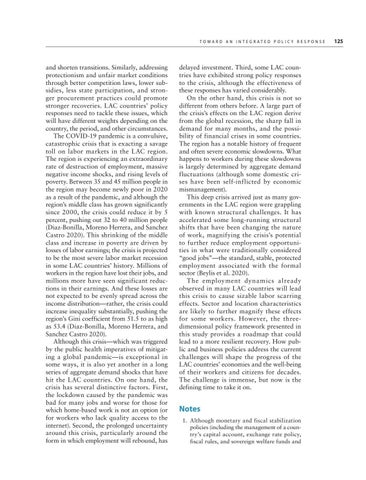T o w a r d a n I n t e g r a t e d P o l i c y R e s p o n s e
and shorten transitions. Similarly, addressing protectionism and unfair market conditions through better competition laws, lower subsidies, less state participation, and stronger procurement practices could promote stronger recoveries. LAC countries’ policy responses need to tackle these issues, which will have different weights depending on the country, the period, and other circumstances. The COVID-19 pandemic is a convulsive, catastrophic crisis that is exacting a savage toll on labor markets in the LAC region. The region is experiencing an extraordinary rate of destruction of employment, massive negative income shocks, and rising levels of poverty. Between 35 and 45 million people in the region may become newly poor in 2020 as a result of the pandemic, and although the region’s middle class has grown significantly since 2000, the crisis could reduce it by 5 percent, pushing out 32 to 40 million people (Diaz-Bonilla, Moreno Herrera, and Sanchez Castro 2020). This shrinking of the middle class and increase in poverty are driven by losses of labor earnings; the crisis is projected to be the most severe labor market recession in some LAC countries’ history. Millions of workers in the region have lost their jobs, and millions more have seen significant reductions in their earnings. And these losses are not expected to be evenly spread across the income distribution—rather, the crisis could increase inequality substantially, pushing the region’s Gini coefficient from 51.5 to as high as 53.4 (Diaz-Bonilla, Moreno Herrera, and Sanchez Castro 2020). Although this crisis—which was triggered by the public health imperatives of mitigating a global pandemic—is exceptional in some ways, it is also yet another in a long series of aggregate demand shocks that have hit the LAC countries. On one hand, the crisis has several distinctive factors. First, the lockdown caused by the pandemic was bad for many jobs and worse for those for which home-based work is not an option (or for workers who lack quality access to the internet). Second, the prolonged uncertainty around this crisis, particularly around the form in which employment will rebound, has
delayed investment. Third, some LAC countries have exhibited strong policy responses to the crisis, although the effectiveness of these responses has varied considerably. On the other hand, this crisis is not so different from others before. A large part of the crisis’s effects on the LAC region derive from the global recession, the sharp fall in demand for many months, and the possibility of financial crises in some countries. The region has a notable history of frequent and often severe economic slowdowns. What happens to workers during these slowdowns is largely determined by aggregate demand fluctuations (although some domestic crises have been self-inflicted by economic mismanagement). This deep crisis arrived just as many governments in the LAC region were grappling with known structural challenges. It has accelerated some long-running structural shifts that have been changing the nature of work, magnifying the crisis’s potential to further reduce employment opportunities in what were traditionally considered “good jobs”—the standard, stable, protected employment associated with the formal sector (Beylis et al. 2020). T he employment dynamics already observed in many LAC countries will lead this crisis to cause sizable labor scarring effects. Sector and location characteristics are likely to further magnify these effects for some workers. However, the three- dimensional policy framework presented in this study provides a roadmap that could lead to a more resilient recovery. How public and business policies address the current challenges will shape the progress of the LAC countries’ economies and the well-being of their workers and citizens for decades. The challenge is immense, but now is the defining time to take it on.
Notes 1. Although monetary and fiscal stabilization policies (including the management of a country’s capital account, exchange rate policy, fiscal rules, and sovereign welfare funds and
125

